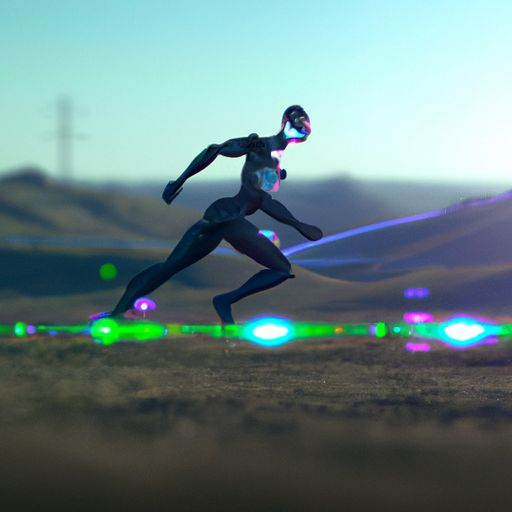The Future of Athletics: How Technology is Revolutionizing Sports

The Impact of Wearable Technology on Philippine Sports
The world of sports has always been a place where athletes push themselves to their limits, striving to achieve new heights and break records. However, with the advent of technology, the way we approach sports has changed dramatically. Wearable technology, in particular, has revolutionized the way athletes train, compete, and recover. In the Philippines, wearable technology has made a significant impact on sports, helping athletes to improve their performance and stay ahead of the competition.
One of the most significant benefits of wearable technology is the ability to track an athlete’s performance in real-time. Wearable devices such as fitness trackers, smartwatches, and heart rate monitors can provide athletes with valuable data on their heart rate, speed, distance, and other metrics. This data can be used to identify areas where an athlete needs to improve and to track progress over time. Coaches and trainers can use this data to create personalized training programs that are tailored to the athlete’s specific needs.
Another way that wearable technology is changing the game is by providing athletes with instant feedback. For example, smart clothing can provide haptic feedback to athletes, letting them know when they are in the correct position or when they need to adjust their form. This can be particularly useful for athletes who are learning a new skill or trying to perfect their technique. By providing instant feedback, wearable technology can help athletes to make adjustments quickly and improve their performance.
Wearable technology is also helping athletes to recover more quickly from injuries. Devices such as compression sleeves and boots can help to improve circulation and reduce inflammation, which can speed up the healing process. Athletes can also use wearable devices to track their sleep patterns, which can be crucial for recovery. By monitoring their sleep, athletes can ensure that they are getting enough rest and can adjust their training schedule accordingly.
In the Philippines, wearable technology is being used in a variety of sports, from basketball to running to martial arts. For example, the Philippine national basketball team has been using wearable technology to track their performance during training and games. The team uses GPS trackers to monitor their speed and distance, heart rate monitors to track their exertion levels, and smart clothing to provide feedback on their form. This data is used to create personalized training programs for each player, helping them to improve their performance and stay healthy.
Wearable technology is also being used in running, with devices such as smart shoes and fitness trackers helping runners to track their distance, speed, and other metrics. This data can be used to identify areas where runners need to improve and to track progress over time. In martial arts, wearable technology is being used to track an athlete’s movements and provide feedback on their technique. This can be particularly useful for athletes who are learning a new skill or trying to perfect their form.
In conclusion, wearable technology is revolutionizing the world of sports, providing athletes with valuable data, instant feedback, and faster recovery times. In the Philippines, wearable technology is being used in a variety of sports, helping athletes to improve their performance and stay ahead of the competition. As technology continues to evolve, we can expect to see even more innovations in the world of sports, making it an exciting time for athletes and fans alike.
Virtual Reality Training: The Future of Athletic Preparation in the Philippines

The world of sports is constantly evolving, and technology is playing a significant role in this evolution. In the Philippines, virtual reality training is becoming increasingly popular among athletes and coaches as a way to prepare for competitions. This technology is revolutionizing the way athletes train and is expected to have a significant impact on the future of athletics.
Virtual reality training involves the use of computer-generated simulations to create a realistic environment for athletes to train in. This technology allows athletes to practice in a safe and controlled environment, where they can make mistakes without the risk of injury. It also allows coaches to monitor and analyze an athlete’s performance in real-time, providing valuable feedback that can be used to improve their technique.
One of the main advantages of virtual reality training is that it allows athletes to train in a variety of different environments. For example, a basketball player can practice shooting in a virtual gym, while a track and field athlete can practice running on a virtual track. This technology also allows athletes to train in different weather conditions, which can be particularly useful for outdoor sports such as football and soccer.
Another advantage of virtual reality training is that it can be customized to meet the specific needs of individual athletes. Coaches can create training programs that are tailored to an athlete’s strengths and weaknesses, allowing them to focus on areas that need improvement. This personalized approach to training can help athletes to reach their full potential and achieve their goals.
Virtual reality training is also a cost-effective way for athletes to train. Traditional training methods often require expensive equipment and facilities, which can be a barrier for many athletes. Virtual reality training, on the other hand, only requires a computer and a headset, making it accessible to athletes of all levels.
The use of virtual reality training is not limited to individual athletes. It can also be used by teams to simulate game situations and develop strategies. For example, a basketball team can use virtual reality to practice offensive and defensive plays, while a soccer team can use it to practice set pieces.
The future of athletics in the Philippines looks bright with the use of virtual reality training. This technology is expected to become more advanced and sophisticated, providing athletes with even more realistic training environments. It is also expected to become more widely available, making it accessible to athletes of all levels.
However, there are also some challenges that need to be addressed. One of the main challenges is the cost of the technology. While virtual reality training is cost-effective compared to traditional training methods, it still requires a significant investment. This may be a barrier for some athletes and teams, particularly those from less affluent backgrounds.
Another challenge is the need for specialized training and support. Coaches and trainers need to be trained in the use of virtual reality technology to ensure that athletes receive the best possible training. This requires a significant investment in training and support, which may be a challenge for some organizations.
In conclusion, virtual reality training is revolutionizing the way athletes train in the Philippines. This technology is providing athletes with a safe and controlled environment to practice in, allowing them to improve their technique and reach their full potential. While there are some challenges that need to be addressed, the future of athletics in the Philippines looks bright with the use of virtual reality training.
The Role of Artificial Intelligence in Enhancing Athletic Performance in the Philippines
The world of sports has always been a place where athletes push themselves to their limits, striving to achieve new heights of performance. In recent years, technology has played an increasingly important role in helping athletes achieve their goals. One area where technology is having a significant impact is in the use of artificial intelligence (AI) to enhance athletic performance.
In the Philippines, AI is being used to help athletes improve their performance in a variety of sports. One example is in the sport of basketball, where AI is being used to analyze player movements and provide feedback on how to improve their technique. By analyzing data from sensors placed on players’ bodies, AI algorithms can identify areas where players need to improve their form or adjust their movements to be more efficient.
Another area where AI is being used in the Philippines is in the sport of running. By analyzing data from sensors placed on runners’ shoes, AI algorithms can provide feedback on how to improve their running form and reduce the risk of injury. This technology is particularly useful for long-distance runners, who need to maintain proper form over extended periods of time.
AI is also being used to help athletes improve their mental performance. By analyzing data from brain sensors, AI algorithms can identify patterns in an athlete’s brain activity that are associated with optimal performance. This information can then be used to help athletes develop mental strategies that will help them perform at their best.
One of the most exciting applications of AI in sports is in the area of predictive analytics. By analyzing data from past performances, AI algorithms can predict how athletes will perform in future competitions. This information can be used to help coaches develop training programs that are tailored to each athlete’s strengths and weaknesses, as well as to help athletes prepare mentally for upcoming competitions.
While AI is still in its early stages of development in the Philippines, it has the potential to revolutionize the way athletes train and compete. By providing real-time feedback on technique and form, AI can help athletes make rapid improvements in their performance. And by analyzing data from past performances, AI can help athletes and coaches develop strategies that will give them a competitive edge.
Of course, there are also potential downsides to the use of AI in sports. One concern is that athletes may become too reliant on technology, and may lose the ability to rely on their own instincts and intuition. Another concern is that the use of AI may create an uneven playing field, with athletes who have access to the latest technology having an unfair advantage over those who do not.
Despite these concerns, the use of AI in sports is likely to continue to grow in the coming years. As the technology becomes more advanced and more widely available, it will become an increasingly important tool for athletes and coaches alike. And as AI continues to evolve, it may even lead to new breakthroughs in sports science, helping athletes achieve levels of performance that were once thought impossible.
In conclusion, the use of AI in sports is a rapidly growing field that has the potential to revolutionize the way athletes train and compete. In the Philippines, AI is already being used to help athletes improve their performance in a variety of sports, from basketball to running. While there are potential downsides to the use of AI in sports, the benefits are clear: by providing real-time feedback on technique and form, and by analyzing data from past performances, AI can help athletes achieve new levels of performance and compete at the highest levels of their sport.

